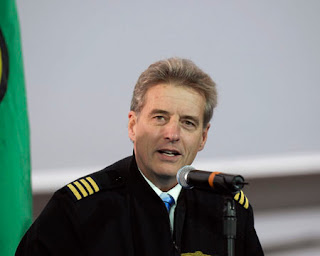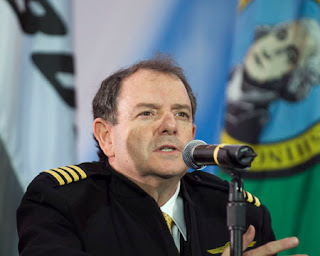 When the Boeing 787 Dreamliner made its long-awaited first flight earlier this week, Capt. Mike Carriker, pictured at right, was commanding the aircraft. Capt. Carriker is Boeing's chief pilot for the 787 program. In the Dreamliner cockpit's right hand seat was Capt. Randy Neville, pictured below.
When the Boeing 787 Dreamliner made its long-awaited first flight earlier this week, Capt. Mike Carriker, pictured at right, was commanding the aircraft. Capt. Carriker is Boeing's chief pilot for the 787 program. In the Dreamliner cockpit's right hand seat was Capt. Randy Neville, pictured below.An article about the 787's first flight on Wired.com's Autopia blog profiles the two pilots this way:
Boeing brought in two of its best for the 787’s first flight. Carriker is chief pilot on the 787 program and was a Navy pilot before joining Boeing in 1990. He’s made more than 300 carrier landings flying the A-7E Corsair and F/A-18 Hornet. In addition to flying the 787, Carriker was a chief test pilot on the 737 program and the assistant project pilot on the X-32 Joint Strike Fighter program when Boeing was competing for the contract. He also is checked out in the 1933 Boeing 247D, the company’s first all-metal airliner.About the flight
Air Force veteran Randy Neville flew in right seat for the first flight. Neville spent 20 years flying F-106 Delta Darts and F-16 Fighting Falcons. He is a graduate of the USAF Test Pilot school and went on to weapons testing in the F-4 and F-16. Neville also flew the F-22 Raptor while at Edwards Air Force Base in California.
On December 15, 2009 at 10:27 local time, the new aircraft departed Paine Field in Everett, WA on its maiden flight. Carriker and Neville kept the aircraft aloft for about three hours, testing some of the Dreamliner's systems and structures, while on-board equipment recorded and transmitted real-time data to a flight-test team at Boeing Field. They took the aircraft to an altitude of 13,200 feet (4,023 meters) and an air speed of 180 knots, or about 207 miles (333 kilometers) per hour -- which Boeing says is customary on a first flight. At about 13:33 local time, the 787 landed for the time at Seattle's Boeing Field.
 Upon landing, the pair of pilots participated in a news conference about the first 787 flight. Both seemed enthusiastic about the aircraft and the experience of flying it (and who wouldn't?!).
Upon landing, the pair of pilots participated in a news conference about the first 787 flight. Both seemed enthusiastic about the aircraft and the experience of flying it (and who wouldn't?!).Carriker, replying to a question, said, "Is it a relief? Yes. Would I like to go get another 20,000 pounds of gas and good weather and go again? You bet I would. Make that about 80,000 pounds of gas."
Neville said, "The airplane flew great. There were no surprises and the airplane did exactly as we were expecting -- and that's goodness from the pilot viewpoint."
Neville talked about the progression of the flight: "We took off with flaps 20, the normal take off setting and we stayed there for quite a ways. We were at flaps 20 for the bulk of the mission, that was with the gear down. We ultimately got to flaps 30, we cycled the landing gear, that was a big point we wanted to do. We brought the gear up then we both breathed a big sigh of relief when we put it back down and it came down properly."
In addition to the aircraft itself, a highlight for Carriker turned out to be the scenery from his 'office window': "We popped out of the top of the clouds at about 7,000 feet and there was the snow-capped Olympics, the Straits of San Juan, all framed in the front left window of a 787 at 10,000 feet. That image will be in my mind for the rest of my life."
By the way, they greased the landing at Boeing field, and rolled out straight down the runway's center line.
According to Boeing, the 787's first flight marks the beginning of a flight-test program that will see six airplanes "flying nearly around the clock and around the globe," with the first 787 scheduled for delivery in the fourth-quarter 2010. Like the first aircraft, three more of the 787s in the test program will be powered by two Rolls-Royce Trent 1000 engines,while two will be powered by General Electric GEnx engines.
Congratulations to Mike Carriker, Randy Neville, and all the folks at Boeing for the successful first flight of the beautiful new Boeing 787 Dreamliner.
UPDATE Jan. 4, 2010: Michael Carriker, the pilot in command of the first flight of the Boeing 787, was interviewed recently for EAA Radio. He talked about "the 787, test flying, belonging to EAA, and if it's possible to put a Hatz biplane on floats." In case you missed it on the EAA Web site, here is the link to the MP3 audio file of the EAA interview with Michael Carriker.
[Photo Source]
